The Bi-icositetradiminished 600-cell
The 120 vertices of the 600-cell can divided into 5 sets of 24 vertices each, corresponding with 5 inscribed 24-cells. If we remove the 24 vertices of one of these 24-cells, the convex hull of the remaining vertices forms a snub 24-cell. If we remove the 48 vertices corresponding to two of these 24-cells, the convex hull of the remaining 72 vertices is a polychoron with 48 cells, all of which are tridiminished icosahedra (J63), along with 192 polygons (120 triangles, 72 pentagons), 216 edges, and 72 vertices. This we call the bi-icositetradiminished 600-cell.
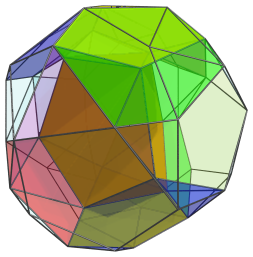
The bi-icositetradiminished 600-cell is a member of the CRF polychora, a class of non-uniform, convex, regular-faced polychora that generalizes the Johnson solids to 4D. All of its ridges are regular polygons, and all of its cells are Johnson solids. Unlike many of the CRF polychora, however, which generally have a low degree of symmetry, the bi-icositetradiminished 600-cell has an interesting skew symmetry directly related to the Hopf fibration of the 4D sphere. This symmetry makes it both vertex-transitive and cell-transitive, which is quite unusual for CRF polychora. This will become clear below as we explore its structure.
Structure
A Central Column
We shall explore the structure of the bi-icositetradiminished 600-cell by means of its parallel projection into 3D.
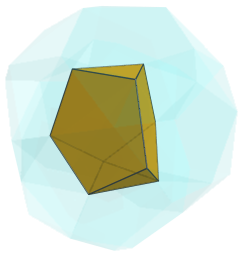
The above image shows the nearest cell to the 4D viewpoint. For clarity, we omit edges and vertices not on this nearest cell, and render all other cells in a transparent color.
For convenience of description, we'll refer to the triangular face surrounded by pentagons as the “top” face of the tridiminished icosahedron, and the triangular face surrounded by other triangular faces as the “bottom” face. The three remaining triangular faces that surround the bottom face will be referred to as the “lateral” triangles. We shall use this terminology to identify specific faces of all of the tridiminished icosahedra we will encounter, even if their projection images may appear in other orientations such that their “top” face won't really be at the top.
The top face of this nearest cell is joined to the bottom face of another tridiminished icosahedron, as shown below:
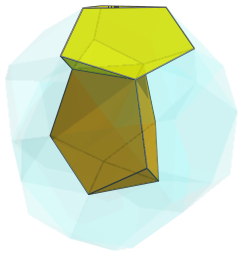
This tridiminished icosahedron appears flattened, because it is seen from a 60° angle. In 4D, it is exactly the same shape as the nearest cell.
The bottom face of the nearest cell is joined to the top face of a third tridiminished icosahedron:
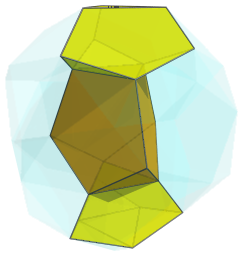
Three Chains
The lateral triangles of the nearest cell are joined to 3 other tridiminished icosahedra:
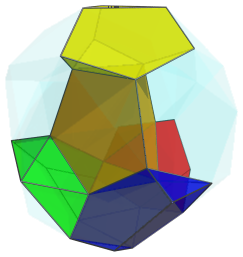
Each of these tridiminished icosahedra also shares a pentagonal face with the bottom yellow cell.
One thing that may not be immediately obvious is their orientation: their top faces are actually pointing downwards towards the bottom of the projection image, and their bottom faces are pointing upwards and to one side. To help the reader see their orientation, the following two images show the bottom faces (left) and top faces (right) of these cells:
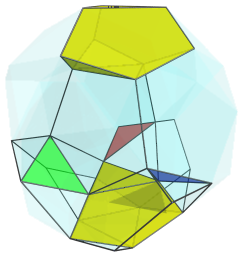
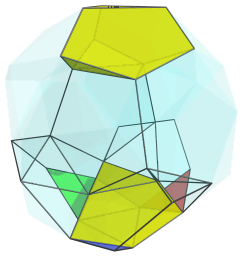
For clarity, we've hidden the ridges of the nearest cell, leaving only its edge outline, so that the placement of the bottom faces relative to it is clear.
Thus, these three cells are arranged around the central column of three cells in a kind of skew-circular fashion. Their bottom faces are joined to three more tridiminished icosahedra, each of which shares a pentagonal face with the nearest cell.
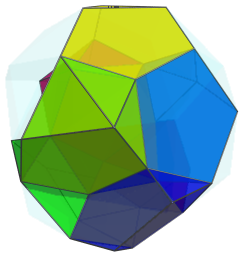
If you look carefully, you'll notice that the top faces of these cells are joined to the bottom faces of the previous 3 cells. Thus, we see a continuation of the pattern that the top face of each cell is joined to the bottom face of another cell, and vice versa. This is an important feature of the symmetry of the bi-icositetradiminished 600-cell, as we will see later.
The bottom faces of these cells are joined to yet another 3 cells, which share a pentagonal face with the yellow cell at the top of the projection image. These cells are shown next:
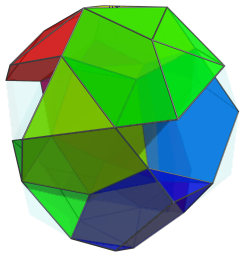
At this point, you may have noticed something interesting: these latest cells are joined to the previous cells' bottom faces by their top faces, and the previous cells are also joined in the same way to the original set of red/green/blue cells, forming three chains of cells that are spiralling around the central column of cells. The following images try to show this spiralling structure more clearly by showing each chain separately:
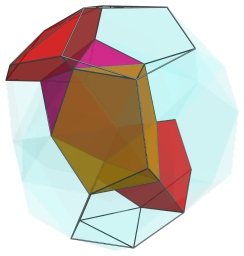
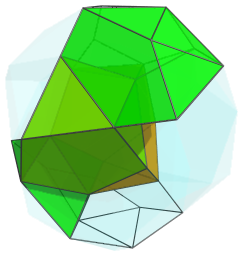
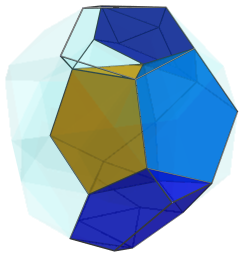
For clarity, we show only the edge wireframe of the top and bottom cells in the central column. We have deliberately chosen the colorings of the cells so that cells in the same chain have similar colors. The wrapping of these chains around the central column is especially obvious with the blue chain.
Another Three Chains
Coming back to the previous image that shows all 4 chains together:

There are some obvious gaps where it looks like other chains of cells might fit in. Indeed, these are the locations of 3 other chains, which are spiralling at a shallower angle:
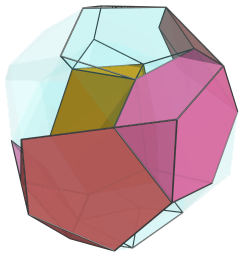
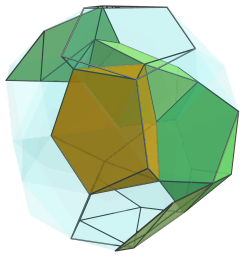
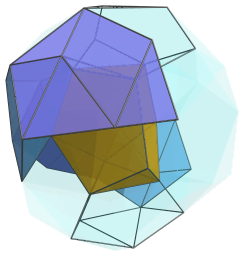
The topmost and bottommost cells of each of these rings appear to be flattened into irregular pentagons: this is because they lie on the limb, or the “equator”, of the bi-icositetradiminished 600-cell, and are seen at a 90° angle. In 4D, they are exactly the same as all the other cells.
Here are all 6 spiralling chains together:
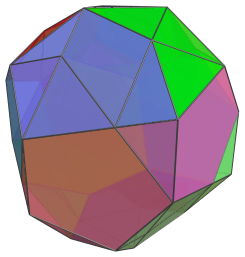
Together with the central column of cells, there are altogether 7 sets of cells, 4 sets with 3 cells each, and 3 sets with 4 cells each, making a total of 24 cells. Six of these cells lie on the equator, and the remaining 18 are on the “near side” of the bi-icositetradiminished 600-cell.
The Equator
Now let's look at the other cells on the equator. Besides the 6 we have already seen, there are 6 other cells. These occur in a 6-membered ring in which each cell is joined to two other members of the ring via their top and bottom faces:
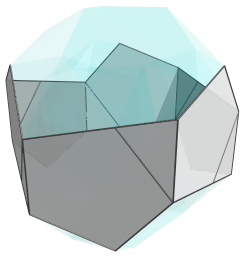
For the sake of clarity, we render all of the other cells we've seen so far in a light transparent color so that the equatorial ring is clearly visible.
The cells of this equatorial ring lie along a great circle on the surface of the bi-icositetradiminished 600-cell; this fact, together with the fact that the members of this ring are all attached to each other via their top and bottom faces, suggests that the spiralling chains we saw earlier are merely parts of their respective complete 6-membered rings. As we shall see, this is, in fact, the case.
Before we do so, let's see all the equatorial cells together:
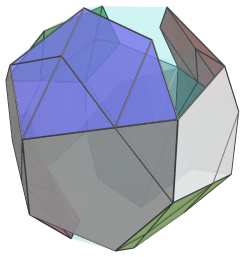
These are the 12 cells that lie on the equator. There remain two groups of triangular faces on the equator that we haven't seen yet:
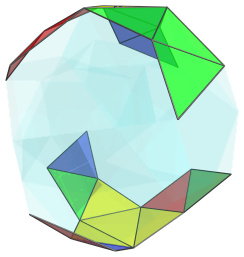
There are 20 triangles in total. They are not the projection image of any equatorial cells; they are where cells on the near side touch cells on the far side. Their colors show which chains they touch.
Here are all the faces that lie on the equator, showing the projection envelope of the bi-icositetradiminished 600-cell:
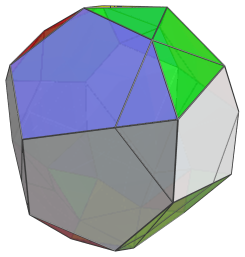
The Far Side
Now we come to the far side. As we've mentioned before, the chains we saw before were in fact segments of complete rings of 6 cells each. Take, for example, the central column of cells, which includes the nearest cell:

The top and bottom faces of this column are joined to another column of 3 cells on the far side, shown next:
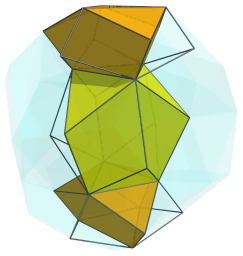
For comparison, we have left the edge outline of the column on the near side visible. Notice that the orientation of these cells is inverted relative to the near side cells. Thus, if we assign a direction to each cell, going from the bottom face to the top face, then all 6 cells together form a directed cycle of 6 cells. So they form a ring of 6 cells. Here are all 6 cells together:
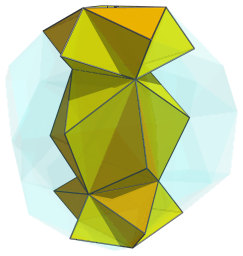
They appear to be interpenetrating, but this is merely because both halves of the ring lie along the same line of sight. In 4D, they form regular hexagonal ring.
Three Complete Rings
Recall the first three chains on the near side:
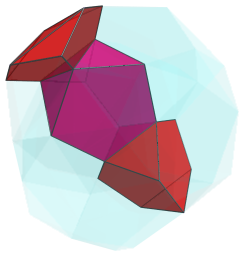
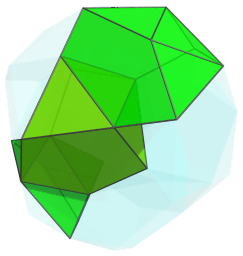
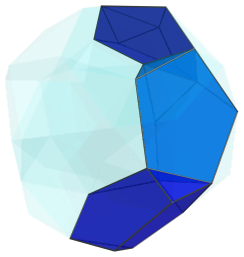
These are halves of complete 6-membered rings. The other halves lie on the far side, as shown next:
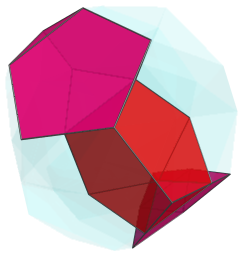
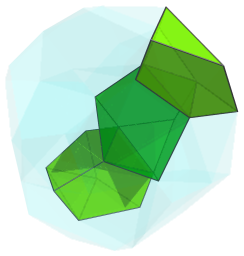
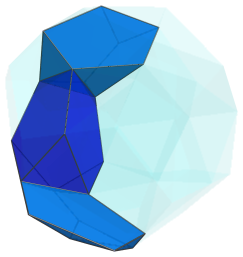
Here are the complete rings:
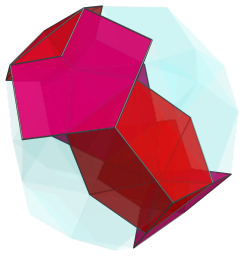
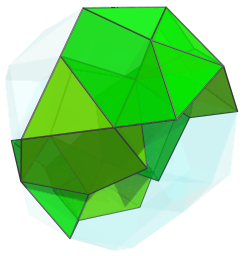
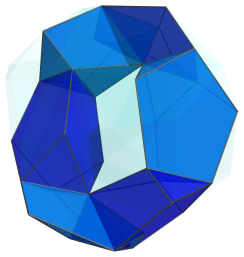
Three More Complete Rings
Recall the second set of three chains earlier:
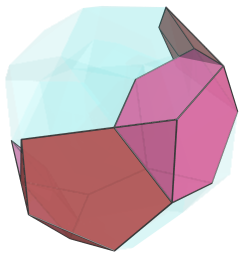
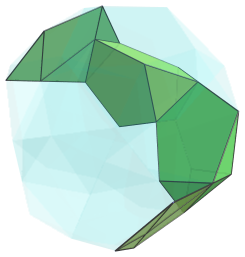
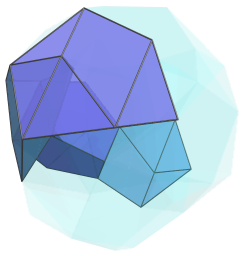
Each of these chains are completed by two more cells each, on the far side:
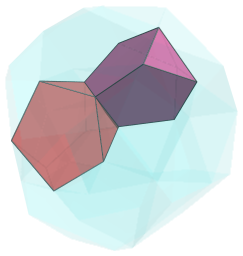
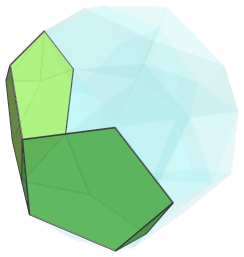
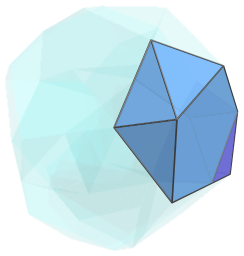
Here are the complete rings:
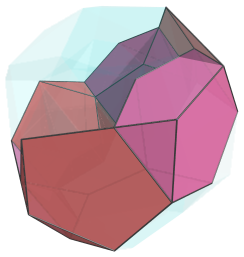
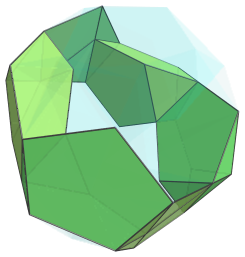
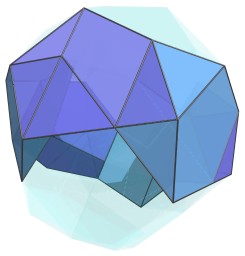
Summary
Thus, there are 8 rings in total: the vertical ring including the nearest cell; the 3 rings immediately surrounding it; the 3 other rings at a shallower angle; and the grey and white ring on the equator. Each ring has 6 cells, and therefore there are 48 cells in total.
These rings are actually all equivalent to each other via an appropriate rotation. Each cell in a ring is also equivalent to the other cells in the ring. The bi-icositetradiminished 600-cell is therefore cell-transitive. This ringed structure directly corresponds with the Hopf fibration of the 4D sphere: each ring corresponds with a fibre, and they spiral, or swirl, around each other to close up the surface of the polytope. This kind of structure corresponds with the class of non-convex uniform polychora known as the swirlprisms, and also reflects the structure of Jonathan Bowers' regular polytwisters.
Animations
The following animation shows the first and fourth rings rotating in the plane of the first ring.
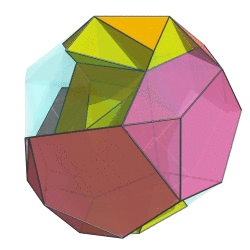
The alternating orientation of the cells is quite obvious. The cells appear to be mutually intersecting, but this is only an artifact of the projection. In 4D the cells do not intersect each other.
Coordinates
The Cartesian coordinates of the bi-icositetradiminished 600-cell are:
|
|
|
|
where φ=(1+√5)/2 is the Golden Ratio.




